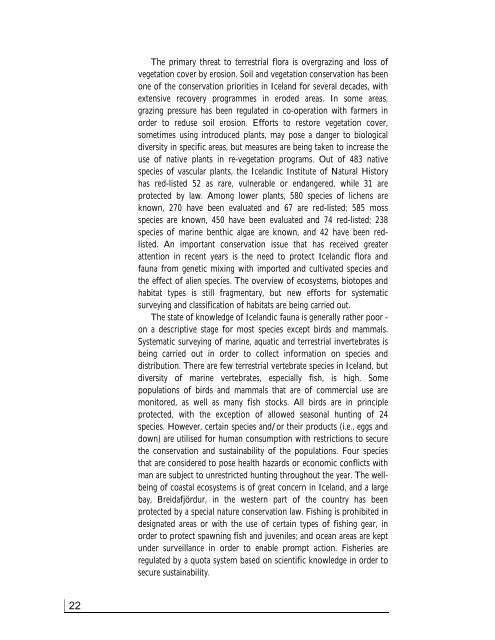BIOLOGICAL DIVERSITY IN ICELAND - Convention on Biological ...
BIOLOGICAL DIVERSITY IN ICELAND - Convention on Biological ...
BIOLOGICAL DIVERSITY IN ICELAND - Convention on Biological ...
- No tags were found...
Create successful ePaper yourself
Turn your PDF publications into a flip-book with our unique Google optimized e-Paper software.
22The primary threat to terrestrial flora is overgrazing and loss ofvegetati<strong>on</strong> cover by erosi<strong>on</strong>. Soil and vegetati<strong>on</strong> c<strong>on</strong>servati<strong>on</strong> has been<strong>on</strong>e of the c<strong>on</strong>servati<strong>on</strong> priorities in Iceland for several decades, withextensive recovery programmes in eroded areas. In some areas,grazing pressure has been regulated in co-operati<strong>on</strong> with farmers inorder to reduse soil erosi<strong>on</strong>. Efforts to restore vegetati<strong>on</strong> cover,sometimes using introduced plants, may pose a danger to biologicaldiversity in specific areas, but measures are being taken to increase theuse of native plants in re-vegetati<strong>on</strong> programs. Out of 483 nativespecies of vascular plants, the Icelandic Institute of Natural Historyhas red-listed 52 as rare, vulnerable or endangered, while 31 areprotected by law. Am<strong>on</strong>g lower plants, 580 species of lichens areknown, 270 have been evaluated and 67 are red-listed; 585 mossspecies are known, 450 have been evaluated and 74 red-listed; 238species of marine benthic algae are known, and 42 have been redlisted.An important c<strong>on</strong>servati<strong>on</strong> issue that has received greaterattenti<strong>on</strong> in recent years is the need to protect Icelandic flora andfauna from genetic mixing with imported and cultivated species andthe effect of alien species. The overview of ecosystems, biotopes andhabitat types is still fragmentary, but new efforts for systematicsurveying and classificati<strong>on</strong> of habitats are being carried out.The state of knowledge of Icelandic fauna is generally rather poor -<strong>on</strong> a descriptive stage for most species except birds and mammals.Systematic surveying of marine, aquatic and terrestrial invertebrates isbeing carried out in order to collect informati<strong>on</strong> <strong>on</strong> species anddistributi<strong>on</strong>. There are few terrestrial vertebrate species in Iceland, butdiversity of marine vertebrates, especially fish, is high. Somepopulati<strong>on</strong>s of birds and mammals that are of commercial use arem<strong>on</strong>itored, as well as many fish stocks. All birds are in principleprotected, with the excepti<strong>on</strong> of allowed seas<strong>on</strong>al hunting of 24species. However, certain species and/or their products (i.e., eggs anddown) are utilised for human c<strong>on</strong>sumpti<strong>on</strong> with restricti<strong>on</strong>s to securethe c<strong>on</strong>servati<strong>on</strong> and sustainability of the populati<strong>on</strong>s. Four speciesthat are c<strong>on</strong>sidered to pose health hazards or ec<strong>on</strong>omic c<strong>on</strong>flicts withman are subject to unrestricted hunting throughout the year. The wellbeingof coastal ecosystems is of great c<strong>on</strong>cern in Iceland, and a largebay, Breidafjördur, in the western part of the country has beenprotected by a special nature c<strong>on</strong>servati<strong>on</strong> law. Fishing is prohibited indesignated areas or with the use of certain types of fishing gear, inorder to protect spawning fish and juveniles; and ocean areas are keptunder surveillance in order to enable prompt acti<strong>on</strong>. Fisheries areregulated by a quota system based <strong>on</strong> scientific knowledge in order tosecure sustainability.
















